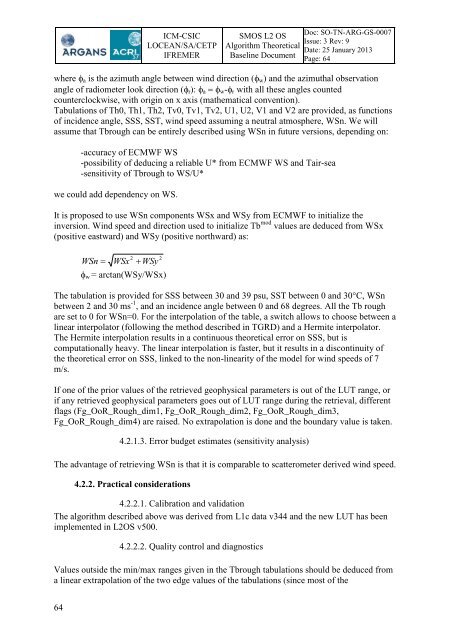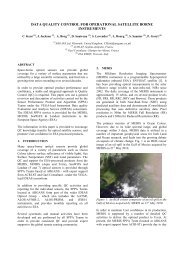SMOS L2 OS ATBD - ARGANS
SMOS L2 OS ATBD - ARGANS
SMOS L2 OS ATBD - ARGANS
Create successful ePaper yourself
Turn your PDF publications into a flip-book with our unique Google optimized e-Paper software.
64<br />
ICM-CSIC<br />
LOCEAN/SA/CETP<br />
IFREMER<br />
<strong>SM<strong>OS</strong></strong> <strong>L2</strong> <strong>OS</strong><br />
Algorithm Theoretical<br />
Baseline Document<br />
Doc: SO-TN-ARG-GS-0007<br />
Issue: 3 Rev: 9<br />
Date: 25 January 2013<br />
Page: 64<br />
where ais the azimuth angle between wind direction (w) and the azimuthal observation<br />
angle of radiometer look direction (r): aw-r with all these angles counted<br />
counterclockwise, with origin on x axis (mathematical convention).<br />
Tabulations of Th0, Th1, Th2, Tv0, Tv1, Tv2, U1, U2, V1 and V2 are provided, as functions<br />
of incidence angle, SSS, SST, wind speed assuming a neutral atmosphere, WSn. We will<br />
assume that Tbrough can be entirely described using WSn in future versions, depending on:<br />
-accuracy of ECMWF WS<br />
-possibility of deducing a reliable U* from ECMWF WS and Tair-sea<br />
-sensitivity of Tbrough to WS/U*<br />
we could add dependency on WS.<br />
It is proposed to use WSn components WSx and WSy from ECMWF to initialize the<br />
inversion. Wind speed and direction used to initialize Tb mod values are deduced from WSx<br />
(positive eastward) and WSy (positive northward) as:<br />
2<br />
WSn WSx WSy<br />
w = arctan(WSy/WSx)<br />
2<br />
The tabulation is provided for SSS between 30 and 39 psu, SST between 0 and 30°C, WSn<br />
between 2 and 30 ms -1 , and an incidence angle between 0 and 68 degrees. All the Tb rough<br />
are set to 0 for WSn=0. For the interpolation of the table, a switch allows to choose between a<br />
linear interpolator (following the method described in TGRD) and a Hermite interpolator.<br />
The Hermite interpolation results in a continuous theoretical error on SSS, but is<br />
computationally heavy. The linear interpolation is faster, but it results in a discontinuity of<br />
the theoretical error on SSS, linked to the non-linearity of the model for wind speeds of 7<br />
m/s.<br />
If one of the prior values of the retrieved geophysical parameters is out of the LUT range, or<br />
if any retrieved geophysical parameters goes out of LUT range during the retrieval, different<br />
flags (Fg_OoR_Rough_dim1, Fg_OoR_Rough_dim2, Fg_OoR_Rough_dim3,<br />
Fg_OoR_Rough_dim4) are raised. No extrapolation is done and the boundary value is taken.<br />
4.2.1.3. Error budget estimates (sensitivity analysis)<br />
The advantage of retrieving WSn is that it is comparable to scatterometer derived wind speed.<br />
4.2.2. Practical considerations<br />
4.2.2.1. Calibration and validation<br />
The algorithm described above was derived from L1c data v344 and the new LUT has been<br />
implemented in <strong>L2</strong><strong>OS</strong> v500.<br />
4.2.2.2. Quality control and diagnostics<br />
Values outside the min/max ranges given in the Tbrough tabulations should be deduced from<br />
a linear extrapolation of the two edge values of the tabulations (since most of the



